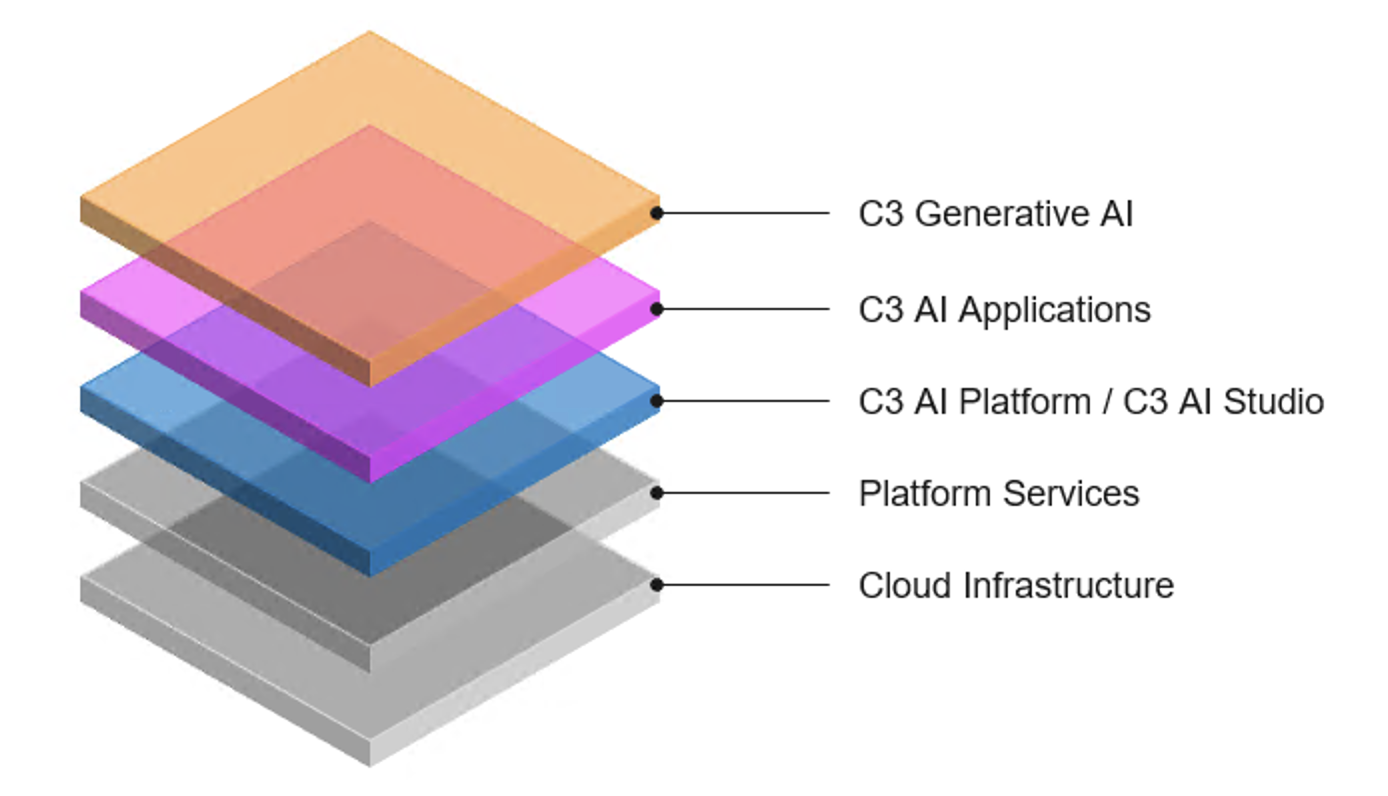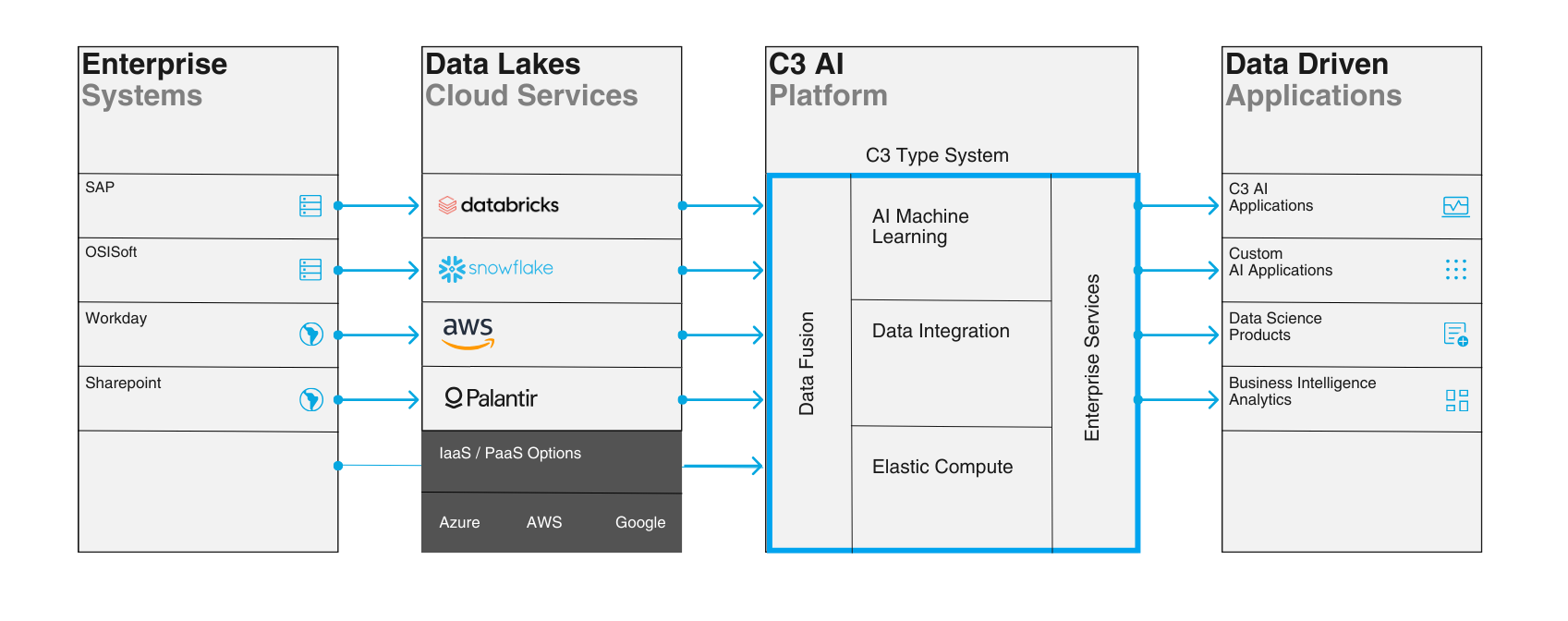Learn about the C3 Agentic AI Platform
Platform Overview
Learn what the C3 Agentic AI Platform is.
The C3 Agentic AI Platform is a system for developing and operating AI applications. It includes a suite of prebuilt applications and an underlying framework for quickly building scalable applications called the C3 AI Type System.
At a high level, building an AI application today requires:
 The C3 Agentic AI Platform is vertically integrated. It includes infrastructure abstraction, core services, a unified modeling environment, application tooling, and generative AI interfaces.
The C3 Agentic AI Platform is vertically integrated. It includes infrastructure abstraction, core services, a unified modeling environment, application tooling, and generative AI interfaces.
 Applications connect to enterprise systems and data lakes through platform-managed services. Core components—including machine learning, data integration, and compute—are modeled and executed in the same environment.
Applications connect to enterprise systems and data lakes through platform-managed services. Core components—including machine learning, data integration, and compute—are modeled and executed in the same environment.
Learn how the core components—models, data pipelines, interfaces, and access policies—come together to form a complete AI application. Explore prebuilt applications
See how C3 AI application suites solve real-world problems in asset performance, supply chain, and generative AI use cases. Begin developing your own application
Start building with the C3 Type System and other core platform components.
- Managing infrastructure that can support high-throughput, multi-tenant workloads
- Handling the movement, transformation, and validation of data from external systems
- Developing machine learning models and integrating them into production systems
- Building user interfaces that reflect live data, support workflows, and enforce security
- Implementing generative interfaces that let users interact with applications using natural language
 The C3 Agentic AI Platform is vertically integrated. It includes infrastructure abstraction, core services, a unified modeling environment, application tooling, and generative AI interfaces.
The C3 Agentic AI Platform is vertically integrated. It includes infrastructure abstraction, core services, a unified modeling environment, application tooling, and generative AI interfaces.
Application Suites
C3 AI delivers a broad portfolio of enterprise-ready applications across multiple industries. The examples below highlight key offerings used to optimize operations, improve planning, and apply generative AI across the enterprise.Asset Performance Suite
The Asset Performance Suite helps asset-intensive organizations reduce downtime, increase efficiency, and extend the life of critical infrastructure.- C3 AI Reliability: AI-enabled predictive maintenance that helps asset operators improve uptime, reduce maintenance costs, and prioritize interventions.
- C3 AI Process Optimization: Dynamic process control recommendations that improve yield, reduce variability, and optimize cost-performance.
- C3 AI Energy Management: Energy monitoring and optimization to reduce emissions, manage consumption, and meet sustainability targets.
Supply Chain Suite
The Supply Chain Suite enables smarter planning and more resilient operations across global networks.- C3 AI Demand Forecasting: Granular, high-frequency forecasts of demand, supply, and capacity—built to reduce stockouts and improve service levels.
- C3 AI Inventory Optimization: AI-driven reorder strategies and policy recommendations that balance cost and service.
- C3 AI Supply Network Risk: Predictive insights into upstream and downstream risks across suppliers, transport routes, and partners.
Generative AI
C3 Generative AI enables users to interact with applications and data using natural language—through copilots, search, summarization, and chat.- C3 Generative AI: Integrates large language models (LLMs) with enterprise data to support question answering, document understanding, and assistant-style workflows.
- Used to enhance other C3 AI applications (e.g., Reliability, Supply Chain, ESG) with conversational interfaces and intelligent helpers.
- Also available as a standalone application for exploring, tagging, and retrieving insights from internal datasets.
Core Components of Application Development
All C3 AI applications are built using the same core components. These provide a consistent way to define data, logic, and compute behavior. To learn how to build your own application using these components, see the Develop section.-
Model-Driven Architecture (C3 AI Type System)
Every C3 AI application starts with the Type System — a structured modeling language that lets you define data relationships, workflows, analytics, and even UI behavior in one place. Because the platform includes prebuilt models for data ingestion, processing, and AI logic, you can focus on what makes your application unique. Instead of writing boilerplate code, you configure reusable components that already handle the heavy lifting. -
AI / Machine Learning
The C3 Agentic AI Platform supports the full lifecycle of machine learning, from data preparation to evaluation and deployment. Developers can define and reuse engineered features, train models on historical data, and evaluate their performance before pushing them into production. Applications can use traditional machine learning models or large language models (LLMs) to support tasks like forecasting, classification, recommendations, and natural language interaction. Once deployed, models run on a fixed schedule, with built-in tools to monitor accuracy, trigger retraining, and track outcomes over time. -
Data Integration
C3 AI applications connect to external systems through reusable connectors that support APIs, cloud storage, databases, and message streams. Incoming data is transformed into canonical formats, enriched, validated, and stored in the platform’s time-series or relational stores. Developers configure pipelines using declarative types that define transformations, scheduling, and error handling. The platform supports both batch and streaming data, with built-in support for backfills, monitoring, and virtualization across sources. -
Elastic Compute
Applications are deployed into environments that scale automatically across a shared compute pool. The platform manages job scheduling, retries, and parallel execution, so teams can run large data loads, model training, or batch scoring without writing orchestration logic. Deployments are portable across cloud or hybrid infrastructure and follow strict isolation boundaries, allowing production workloads to run safely alongside development and test environments.
 Applications connect to enterprise systems and data lakes through platform-managed services. Core components—including machine learning, data integration, and compute—are modeled and executed in the same environment.
Applications connect to enterprise systems and data lakes through platform-managed services. Core components—including machine learning, data integration, and compute—are modeled and executed in the same environment.
Next steps
Understand how C3 applications are structuredLearn how the core components—models, data pipelines, interfaces, and access policies—come together to form a complete AI application. Explore prebuilt applications
See how C3 AI application suites solve real-world problems in asset performance, supply chain, and generative AI use cases. Begin developing your own application
Start building with the C3 Type System and other core platform components.